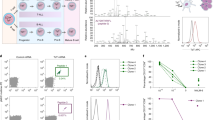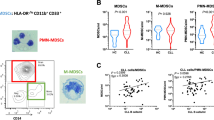Abstract
Both clinical and experimental evidence indicate that T lymphocytes can mediate antileukemic effects in acute myelogenous leukemia (AML). These antileukemic effects can be either nonspecific cytotoxicity (killer cell activity) or reactivity against leukemia-specific antigenic peptides presented by self-HLA molecules. The antigen-specific T cell activation requires recognition of specific peptides together with costimulatory signalling. For most patients the AML blasts express both HLA class I and class II molecules for antigenic presentation, but patients are heterogeneous with regard to: (1) expression of costimulatory binding molecules; (2) expression of receptors/counterreceptors involved in induction of apoptosis; (3) constitutive release of immunomodulatory soluble mediators. This heterogeneity suggests that the ability of AML blasts to initiate an antileukemic T cell response will differ between individual patients. Thus, clinical approaches for immunotherapy in AML have to overcome three major problems. First, the therapy should reduce the patient heterogeneity so that therapeutic effects become more predictable; or alternatively one should define patient subsets which are likely to benefit from immunotherapy. Second, immunotherapy should enhance antileukemic T cell reactivity or blast susceptibility to immune attacks. Third, the therapeutic procedures must be safe and suitable for routine use. All three problems probably have to be solved before immunotherapy can become a routine treatment.
This is a preview of subscription content, access via your institution
Access options
Subscribe to this journal
Receive 12 print issues and online access
$259.00 per year
only $21.58 per issue
Buy this article
- Purchase on Springer Link
- Instant access to full article PDF
Prices may be subject to local taxes which are calculated during checkout
Similar content being viewed by others
Author information
Authors and Affiliations
Rights and permissions
About this article
Cite this article
Bruserud, Ø. Acute myelogenous leukemia blasts as accessory cells during T lymphocyte activation: possible implications for future therapeutic strategies. Leukemia 13, 1175–1187 (1999). https://doi.org/10.1038/sj.leu.2401452
Received:
Accepted:
Published:
Issue Date:
DOI: https://doi.org/10.1038/sj.leu.2401452
Keywords
This article is cited by
-
Future perspectives: should Th17 cells be considered as a possible therapeutic target in acute myeloid leukemia patients receiving allogeneic stem cell transplantation?
Cancer Immunology, Immunotherapy (2011)
-
The Efficient Generation of Immunocompetent Dendritic Cells from Leukemic Blasts in Acute Myeloid Leukemia: A Local Experience
Pathology & Oncology Research (2009)
-
Immunotherapy for myeloid leukemias: current status and future directions
Leukemia (2008)
-
T cells remaining after intensive chemotherapy for acute myelogenous leukemia show a broad cytokine release profile including high levels of interferon-γ that can be further increased by a novel protein kinase C agonist PEP005
Cancer Immunology, Immunotherapy (2007)
-
Effects of interferon gamma on native human acute myelogenous leukaemia cells
Cancer Immunology, Immunotherapy (2006)



